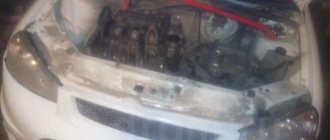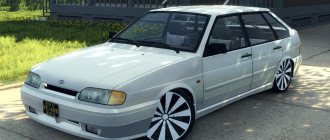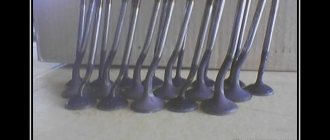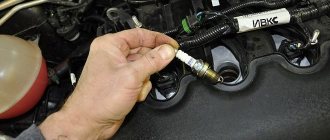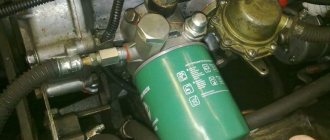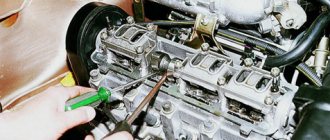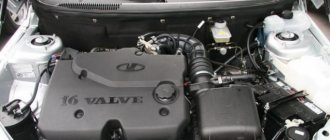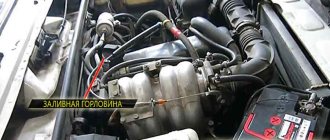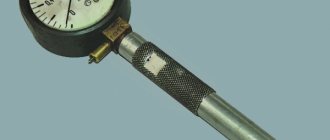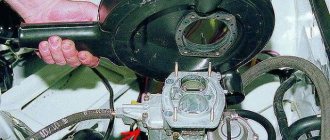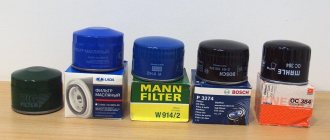Methods for removing a bolt
Below are the most effective ways to remove damaged bolts and screws.
With damaged edges
When deciding how to unscrew a bolt with stripped edges, you need to consider whether there is access to it, its location, and what tool you can use. Based on these factors, you can use one of the following methods:
- Using a chisel. The method is suitable for large bolts that have easy access. All you need is a hammer and chisel. The chisel is applied tangentially to the head and sharp blows are applied to it. The method is simple, but it rarely achieves the desired result. It should only be used when there is no other tool at hand.
- If there is free access to the location of the fastener, you can use a universal adjustable wrench. This tool allows you to securely clamp even a round head. If you use small adjustable cobra-type wrenches, which have sharp notches on the working surfaces, you can unscrew the smallest bolts. Such a tool can help out in many cases, but it must be new. In a worn tool, the notches can no longer provide reliable adhesion to the metal, and the key will slip.
- If the edges are not severely damaged, then socket wrench heads can help out. For these purposes, the ring wrench profile must have 12 edges (there is an asterisk inside the head, not a hexagon). Unscrewing is done as follows. Select a head one size smaller than the size of the bolt, and use a hammer to press it onto the torn edges, then unscrew it in the usual way.
- This method involves using a hacksaw for metal, with which a cut is made on the head of the bolt for a flat screwdriver. The depth of the cut should not be more than 75% of the height of the bolt head; with a greater depth, one of the halves may break off.
- If you have a file or grinder at your disposal, you can restore smaller turnkey edges. If you have an open-end wrench, it is not necessary to cut out a hexagon; it is enough to make two parallel edges.
- If you can use welding at the location of the fastening, this will greatly facilitate the task. In this case, you can put a nut of a suitable diameter on the head and weld them together, and then use regular wrenches.
With the head torn off
Very often, when disassembling old threaded connections, you can not only damage the edges of the bolt, but also tear off the head. Then the question arises: how to unscrew the broken bolt. If you have separated parts and the broken bolt protrudes from the body of the part, then you can use all of the above methods.
How to unscrew a bolt with a torn head if the body of the bolt does not protrude from the part? There are several options for solving this problem.
- It is best to use a special tool - an extractor. The extractor is made of a cylindrical metal rod, at one end of which there is a conical thread of opposite cutting, and at the other - a square shank. In order for it to be used, a hole must be drilled in the center of the bolt. The hole diameter is 2-3 mm less than the thread diameter. After this, you need to take an extractor of a suitable size and hammer it into the hole with a light blow. Rotating the extractor by the shank, unscrew the remaining bolt.
- If you have a left-hand thread tap, you can successfully use it as an extractor. The only difference is that the diameter of the hole must be the same as for threading. The exact value can be found in the corresponding tables.
- If you still can’t unscrew the fragment, you can try to remove it this way. Drill a hole in the bolt with the largest possible diameter, being careful not to damage the threaded connection. Then take the appropriate tap and cut a thread in the hole. During this process, the threads are cleaned and any remaining bolt residue is removed.
How to unscrew a hex without a key
Other ways to unscrew a bolt without a hexagon are as follows:
- If the size of the bolt is not too small, you can use a chisel or an ordinary hammer: they strike at an angle in the direction of unscrewing the fastener.
- Method using a spanner or gas wrench.
- If you have a problem with how to unscrew a “licked” hexagon, you can use a wrench with an attachment. The bolted connection is unscrewed using a hammer mechanism.
- Method of using welding: a small amount of metal with a nut or any piece of reinforcement is welded to the fastener, with the help of which it is then unscrewed.
- The extreme measure for unscrewing hex hardware with an internal axis is to completely dismantle the fastener, when cuts are made with a hammer and the fastener is disassembled.
Andrew Taylor (taylor.a), flickr.com CC BY
Fasteners in modern technology are distinguished by significant diversity. These include regular hex bolts and nuts, flat and Phillips slot screws, Torx sprockets and many others. Parts with an internal hexagon stand apart here. Unscrewing them without a suitable tool is quite difficult.
The internal hex spline first patented in 1936 by the German company Bauer & Schaurte. In foreign technical literature, such screws are usually referred to under the brand name Inbus. This is an abbreviation of the German phrase Innensechskantschraube Bauer und Schaurte - hexagon socket screw from Bauer & Schaurte.
Advantages of internal hexagon
Hexagon socket bolts and screws have a number of advantages over conventional fasteners. Firstly, there is no need to leave space around the head with such a slot for the fastening tool. In this case, you can completely “recess” the screw into the part, which is very convenient for all kinds of drain plugs.
Secondly, the torque transmitted to the part can be almost ten times greater than that of a Phillips-head fastener. Therefore, the Inbus slot is often used in units operating under heavy loads (metalworking machines, road equipment). This also allows the use of small heads for screws with larger shank diameters, ensuring that the same tool size can be used to service different assemblies. Cyclists know this well - one hex key is enough to service a bicycle on the road.
Thirdly, when using a suitable high-quality wrench, it is quite difficult to break the notches of the internal hexagon. The notches hardly wear out, the fasteners can be used repeatedly, which is important for fastening various types of inspection hatches that require frequent opening and closing.
Fourthly, the internal hex wrench is simple and cheap compared to open-end, box and socket wrenches for external hexagons.
And finally, screws with an internal hex head are much safer , since they do not have sharp outer edges, and they also look more aesthetically pleasing.
How to unscrew a hexagon without a key?
Of course, a hex wrench is not out of reach these days. In any store or car market you can pick up a hexagon of any size. But is it worth buying a relatively cheap wrench just to unscrew a tricky screw just once?
This problem is often faced by car enthusiasts who decide to repair their car themselves. The hex socket almost always has a drain plug on the transmission and often a plug in the engine oil pan.
A home craftsman may encounter hexagons when repairing a bathtub faucet or ball valve - ordinary fasteners simply do not fit there.
Moreover, in all these cases the size of the hexagon is quite decent. What to do? A bolt with a regular hex head will help .
The bolt head is inserted into the hexagonal slot and unscrewed by the rod with a gas wrench. You can also screw 3-4 nuts , wedge them well together and unscrew them with a regular spanner.
When unscrewing, you need to twist closest to the head, and when tightening, vice versa, by the farthest one . If the hexagon has a non-standard size, then the head of the key bolt can be sharpened with a file or on a sharpening machine.
What to do if the hexagon is torn off?
It happens that attempts to unscrew a hexagon socket screw using improvised means or a wrench of a slightly inappropriate size lead to the edges breaking off. In this case, too, there is a way out.
a TORX sprocket into it and unscrew it. If the head is accessible, then you should try to unscrew the screw using pliers, a gas wrench or a hand vice.
I tore off the star bolt, how can I unscrew it?
Messages: 1542 Registered: March 30, 2008, 00:00 From: Tyumen Experience: summer 2007 Cars: 206 & 11193 Awards: 1
| Rating: 2,642 |
| Reputation: +6 |
Thanked: 1 time Thanked: 10 times
I tore off the star bolt, how can I unscrew it?
Post by Rusik » March 29, 2012, 10:56 am
I drive: Kia K3
| Rating: 2,872 |
| Reputation: +1 |
Thanked: 3 times Thanked: 5 times
Posted by drake5 » Mar 29, 2012, 11:00 am
Messages: 13939 Registered: Dec 06, 2010, 00:00 From: Tyumen Center Experience: 1976 Car: really like Awards: 2
| Rating: 94,475 |
| Reputation: +194 |
Thanked: 948 times Thanked: 1151 times
Post by Grigoryich » March 29, 2012, 11:12 am
| Rating: 9,948 |
| Reputation: +5 |
Thanked: 23 times Thanked: 104 times
Posted by fullrulez » Mar 29, 2012, 11:13 am
Messages: 1542 Registered: March 30, 2008, 00:00 From: Tyumen Experience: summer 2007 Cars: 206 & 11193 Awards: 1
| Rating: 2,642 |
| Reputation: +6 |
Thanked: 1 time Thanked: 10 times
Post by Rusik » March 29, 2012, 11:18 am
Messages: 3229 Registered: Feb 23, 2007, 00:00 From: Outskirts Experience: 9 years Auto: Submarine Awards: 1
| Rating: 4,985 |
| Reputation: +7 |
Thanked: 1 time Thanked: 21 times
Posted by nemo » Mar 29, 2012, 11:36 am
Messages: 7255 Registered: October 21, 2007, 00:00 From: Tyumen Experience: 2002 Car: Lacetti OKA Niva Awards: 2
| Rating: 19,766 |
| Reputation: +45 |
Thanked: 121 times Thanked: 159 times
Post by black013 » Mar 29, 2012, 11:46 am
Messages: 238 Registered: Oct 12, 2008, 00:00 Experience: 2006 Car: Renault Megane 2 Awards: 1
| Rating: 656 |
| Reputation: +1 |
Thanked: 1 time Thanked: 5 times
Post by MSchumi999 » Mar 29, 2012 12:33 pm
| Rating: 9,948 |
| Reputation: +5 |
Thanked: 23 times Thanked: 104 times
Posted by fullrulez » Mar 29, 2012, 12:45 pm
Autoradio club 27.215 MHz (21C(D) FM)
Messages: 228 Registered: Sep 22, 2011, 00:00
| Rating: 378 |
| Reputation: +1 |
Thanked: 1 time Thanked: 1 time
Post by Alien_C » Mar 29, 2012, 01:05 pm
Messages: 533 Registered: Dec 21, 2011, 00:00
| Rating: 683 |
| Reputation: 0 |
Thanked: 3 times
Post Automotive technical assistance » March 29, 2012, 1:35 pm
Messages: 1992 Registered: July 02, 2009, 00:00 Experience: 2005 Car: Renault Logan 1.6 Awards: 1
| Rating: 4,854 |
| Reputation: +6 |
Thanked: 227 times Thanked: 45 times
Posted by jonjon » Mar 29, 2012 02:50 pm
Messages: 988 Registered: Aug 01, 2010, 00:00 From: Tsar city Tyumen Experience: 2009 Car: saving up for a plane
| Rating: 4,818 |
| Reputation: 0 |
Thanked: 39 times Thanked: 70 times
Posted by REMY111 » Mar 29, 2012, 02:54 pm
Messages: 3168 Registered: May 15, 2009, 00:00 From: left bank of the Yenisei Experience: 1995 Car: mienzubachen Awards: 1
| Rating: 5,077 |
| Reputation: +14 |
Thanked: 1 time Thanked: 10 times
Posted by doctorgeb » Mar 29, 2012, 04:33 pm
Rusik, maybe your sprocket has a smaller diameter than the one in the bolt. try inserting a slightly larger size. The T40 sprocket, in theory, can be unscrewed with a T30 key, or you can rip it off with it. and it will seem that the hole is round.
also like grigorich, he speaks with an impact screwdriver. just take a flat slot of the appropriate size, it should come out
Sooner or later, any owner is faced with a situation where a nut, bolt or self-tapping screw does not want to be unscrewed. There are several reasons for this: low-quality metal, violation of technology (overheated screws), rust, time, too much effort applied when tightening the connection. However, it is possible to unscrew a bolt with torn edges, a licked nut, or a rusty connection. In this article we will talk about how to do this.
Rusted nut
Another problem that is familiar to car enthusiasts (and not only) is a rusted nut and/or thread. In this case, you should not make heroic efforts to unscrew the fasteners. Your edges will simply “stick together” and another problem will be added to the boiling thread. If after a couple of attempts you can’t unscrew it, try the following methods one by one:
- Tap the bolt with a wrench. There is a chance that the rust will crack and the nut will be unscrewed.
- Fill the connection with kerosene and wait. It will eat away the rust, after which it will be easier to unscrew the rusted nut. But during this operation you cannot smoke, turn on welding, or be near an open flame.
Not the most elegant, but effective solution
Removers for broken nuts
You can also fight rust with lubricant. Try filling the joint with fluid universal lubricant (available in WD40 cans). After waiting a couple of hours, we try to work with the key. If it doesn’t work, we try other methods one by one.
Self-tapping screws with stripped splines (asterisk)
If overheated screws are unscrewed/twisted a couple of times, their edges lose their sharpness, the screwdriver turns, but the screw itself remains in place. If it “sits” in wood, plaster, chipboard or other similar, not too hard materials, you can put a thin elastic band (for example, for hair) under the screwdriver. Due to the elastic force, a tighter fit is achieved to the remaining edges, which helps to move the self-tapping screw from its place. Other methods are more “traumatic”:
- Cut grooves inside the “licked” funnel using a flat-head screwdriver and unscrew. This method is quite dangerous: if the walls of the “funnel” are too thin, there is a chance that the screw head will simply crumble from the effort. All that remains is a screw that cannot be unscrewed.
- Drill and unscrew using a small diameter extractor.
- Take a chisel and grind it to the size of the cap. Place it on the cap, hitting it well with a hammer a couple of times. A new cap is formed and, at the same time, existing rust may crumble (if the screw is stuck in the iron). Using the same chisel, try to move the stubborn screw from its place. To make the process easier, you can drop oil on wood or WD40 on metal.
- Drill out the material around the cap, take a tube with an internal diameter slightly larger than the diameter of the cap, and put it on the cap. Pour glue inside. When the glue hardens, unscrew the tube.
The remains of a bolt or stud without a head can be unscrewed as follows: cut a left-hand thread in the remaining body, drip “moment” glue, screw in the left-hand tap, and leave for an hour. Apply some oil to the main thread and leave for an hour. When the glue sets, unscrew it. If the remains of a self-tapping screw are stuck in the wood, it is easier to seal this hole and install another fastener nearby.
How to remove a sprocket from a single-speed bicycle (singlespeed)
To remove the transmission sprocket on a single-speed bike, simply release the locking ring. Many singlespeed fans claim that the “original” locking ring is no good and sometimes breaks, even if there is no talk of replacing the sprocket. In any situation, if the stopper fails, you need to replace it. Otherwise, backlash is inevitable. The chain will simply dangle in different directions.
If the sprockets are faulty, the bike will not ride. Timely replacement of transmission parts is important for all models of bikes: from the simplest “hard workers” to the most sophisticated high-speed highway bikes and mountain bikes.
How to unscrew a hex or sprocket head bolt
In the automotive industry and other equipment, hex tool bolts are often used. How to turn out a torn cap that has broken edges:
- Make a horizontal notch on the head with a grinder or file. In this case, a strong screwdriver is used to unscrew the broken screw.
- Using a special TORX sprocket, which is driven into the head. The nozzle is selected in size, slightly larger than the torn cap, for a strong connection between the walls.
- A set of extractors that can be purchased at a hardware store. Before using the extractor, a hole is drilled with a drill in the base of the bolt, then the extractor is inserted, and the screw is removed with pliers or a special clamp.
- Using a left-handed drill with a slightly smaller hole diameter. Work with the tool is carried out in reverse mode, with this method it is possible to damage the thread.
How to unscrew a bolt with torn edges manually
Broken nuts are more difficult to unscrew, since during work there is a possibility of damage to the threads. The simplest way is to use chemicals; the surfaces are cleaned and treated with the product for 15 minutes. If the edges are torn off, it is impossible to use a wrench or socket. In such cases, a chisel is used to destroy the main part of the nut, then removed and replaced with a new nut.
How to remove a bolt if the head has broken off
A broken head of the structure can cause a lot of trouble during work. How to act in such a difficult situation without resorting to using a serious tool. If the element is small, it is possible to make a notch with a grinder, the recess of which will allow the use of a screwdriver with sharp edges. To perform more complex work, you will need an extractor, drill and reamer. The base of the threaded connection is drilled exactly in the middle, after making the hole, the tool is screwed in counterclockwise.
https://youtube.com/watch?v=PoJ4X-xN2i4
When performing sequential actions, unscrewing a damaged structural element will not be difficult even for those who are encountering this problem for the first time. It is necessary to correctly assess the situation and use a good quality tool for a productive result.
How to drill out a broken bolt
A drill made of high-quality material is used for the work. The size must be selected in accordance with the torn edges; the diameter of the drill should not be larger than the hole. A high-quality drill has a higher price, but its use eliminates rapid wear and the possibility of breakage during operation.
You should use the tool slowly, and before completing the task, correctly assess the situation. It is necessary to monitor the position of the tool during operation; drilling is carried out strictly in the center, without deviations in different directions.
Self-tapping screws with stripped splines (asterisk)
If overheated screws are unscrewed/twisted a couple of times, their edges lose their sharpness, the screwdriver turns, but the screw itself remains in place. If it “sits” in wood, plaster, chipboard or other similar, not too hard materials, you can put a thin elastic band (for example, for hair) under the screwdriver. Due to the elastic force, a tighter fit is achieved to the remaining edges, which helps to move the self-tapping screw from its place. Other methods are more “traumatic”:
- Cut grooves inside the “licked” funnel using a flat-head screwdriver and unscrew. This method is quite dangerous: if the walls of the “funnel” are too thin, there is a chance that the screw head will simply crumble from the effort. All that remains is a screw that cannot be unscrewed.
It’s already difficult to unscrew such a self-tapping screw
Unscrew the self-tapping screw with torn edges (cross)
The remains of a bolt or stud without a head can be unscrewed as follows: cut a left-hand thread in the remaining body, drip “moment” glue, screw in the left-hand tap, and leave for an hour. Apply some oil to the main thread and leave for an hour. When the glue sets, unscrew it. If the remains of a self-tapping screw are stuck in the wood, it is easier to seal this hole and install another fastener nearby.
Surprises are inevitable during renovations. Equipment may fail, a seemingly strong part may break in the most unnecessary place, and bolts and nuts may resist unscrewing. And then the repair drags on, taking extra time, nerves and money.
Nowadays you can find many videos on the Internet with guidance on carrying out any repair work. They say that based on videos from the Internet, you can build a house from scratch and reassemble a car, piece by piece.
But with such a huge number of tips and recommendations, it is difficult to choose the right course of action for you. In this article we will try to collect all available experience and systematize it for ease of use.
How to unscrew a broken bolt?
Basic methods:
- Clean the surface with a metal brush and treat it with diesel fuel or kerosene. They try to unscrew the nut with a spanner. Although there is no absolute guarantee that it will unscrew.
- Using a chisel and hammer, strike in the direction of unscrewing. This method is not suitable for a small nut.
- A gas wrench with a powerful clamp is a good tool in this situation. It is easy for them to grab even round objects, but it is harder in hard-to-reach places. The longer the handle, the easier it is to unscrew.
- When the fastening material is large and difficult to unscrew, you can use welding equipment to apply a metal coating and prepare the desired turnkey shape with a file.
- Use a drill to cut out a hole inside the body of the fastening element, thread an L-shaped rod through it, which will serve as a handle, and remove it.
When there is enough space to use an adjustable wrench or pliers, this is good, but what to do in other situations?
How to unscrew a hex or sprocket head bolt
To remove the element, use a gas wrench to compress the part, make a cut on the head with a grinder and unscrew it with a screwdriver, an extractor of the appropriate size, or special tools (wrench, pin driver), which are beneficial to purchase only if you have to deal with such problems quite often.
Select the TORX sprocket according to size (it should not be large and the slots should fit into the hole for the hexagon). It is inserted tightly into the head and the bolt is jerkily unscrewed to avoid the sprocket spline from breaking off. When driving sprockets with holes in the center, they break off, so their use is not recommended.
Any hardware or auto store sells sets of extractors. Externally, this device looks like a metal rod with a conical thread on the left side and a faceted base on the right. They are used to unscrew nuts with torn edges. To do this, drill a hole strictly in the center of the bolt, drive an extractor of the required size into it and unscrew it with pliers. This is done simply and quickly, because the extractor has the opposite cutting.
Read also: Ax with a long handle
A drill with reverse is an irreplaceable thing. Use a thin drill to make a hole near the bolt. Take a left-hand rotation drill with a smaller diameter and drill out the damaged bolt in inverse rotation mode.
Unscrew the broken bolts and nuts
“Licked” edges on bolt heads or nuts are not that uncommon. Excessive forces that we apply when tightening and then when unscrewing often lead to the fact that the boundary between the edges of the bolt is erased. If the bolt does not unscrew, ordinary wrenches are powerless in this case - they simply turn, and the fasteners remain in place.
Torn or licked edges on a nut or bolt prevent it from being unscrewed
There are several ways to unscrew shear bolts and nuts:
- Using a gas adjustable wrench. Due to the ribbed jaws, adjustable degree of “tightening” and a fairly large lever, an adjustable wrench helps in most cases. This tool is not uncommon, so the first thing to do if you need to unscrew fasteners with licked threads is to try this method.
A gas (pipe) wrench is the best tool for loosening nuts
- Make new edges. Smaller, but clearer. This will allow you to better grip the nut with the same adjustable gas wrench. The edges are made using a grinder. You must work carefully so as not to damage the surface under the nut/bolt head. This is a risky undertaking and should be used as a last resort.
- With a file. This method takes more time, but is safer. If there is no urgency, it is better to straighten the edges with a file.
How to use the extractor
If there is a plastic or rubber gasket under the bolt, remove it and try one of the suggested methods again. If you can’t unscrew a bolt with torn edges using all these methods, there is only one thing left: cut off/saw off the head and drill out the pin.
Stages of installing new stars
How does assembly occur when replacing a bicycle cassette sprocket?
Let's look at it step by step.
- We install a new sprocket and fix it.
- Reassemble the cassette in complete reverse order.
- Using a puller, mount the drum onto the spline mounting area.
- The drum must first be leveled.
- Next, we carry out the process of assembling the sleeve. All actions described in the first paragraph are carried out in reverse order.
- Install the rear wheel and securely fix it.
- We put on the chain.
It is imperative to check the smooth operation of the transmission. This procedure involves adjusting the rear speed derailleur.
If everything was carried out according to the proposed instructions, feel free to get on the bike and enjoy the ride.
Caring for bicycle sprockets
The rubbing mechanisms of a bicycle must be periodically lubricated and cleaned of dirt. This extends the transmission life and makes travel safer. After several trips on bad roads, forests, or, even more so, off-road, the bike turns out to be literally overgrown with mud. If the frame and wheels can be washed clean, then the dirt on the bicycle mechanism is simply not visible. Therefore, after such trips, it is a good idea to inspect the bike and take measures to clean the parts, and, if necessary, replace worn components.
You can clean a bicycle cassette according to this algorithm.
- Release the rim brake. Alternatively, remove the caliper on the disc brake;
- Remove the rear wheel;
- Carefully inspect the cassette. If it is very dirty, you will have to remove it from the wheel and clean it. If there is slight contamination, you can clean the bicycle cassette of dirt without removing it from the wheel;
- Use special narrow brushes for cleaning, which make it possible to penetrate between the gears and clean out what should not be there. In addition, it is much more convenient than getting into the gaps with a rag;
- An old toothbrush works well for cleaning the teeth of the stars;
- Wipe the surfaces with a cloth soaked in kerosene. Then apply lubricant to the teeth and pits;
- It is advisable to clean the cassette with sprockets on the wheel and the chain at the same time. This is the only way to achieve the desired result.
The system is cleaned in the same way. There is no need to remove the bicycle wheel, but you need to work with extreme care so as not to accidentally change the switch setting.
Types of screws
Let's start with the fact that a screw is a cylindrical rod with a special head onto which a screw groove is applied. Screws are produced according to a number of regulatory documents, including GOST 1144-80, GOST 1145-80, etc.
However, there are two main types of hardware:
- classic screws;
- self-tapping (also known as self-tapping screws).
Carving self-tapping screws for metal and wood
For designation in this case, the diameter and length of the screw are used (for example, a product with a diameter of 5 mm and a length of 3.5 cm will be designated as 5x35 mm). In addition, hardware can be classified according to the shape of the slot and the features of the head itself:
- with a flat (countersunk) head;
- with the same, but smaller type;
- with press washer;
- with a hemispherical head.
Read more: How much do rear springs cost on a VAZ 2107
Types of screw heads
All of these varieties are produced with a Phillips slot, with a straight (flat) and with a Torx slot (the latter is also known as an “asterisk”), as well as with an internal hexagon and other, less popular options. There are also self-tapping screws with hexagonal and octagonal heads (roofing), which are also made with different slots.
Why do the edges of a screw, screw or bolt lick off?
Licking is the grinding down of the edges of a bolt or a screwdriver slot on the head of a screw, screw or self-tapping screw. Both masters and beginners can encounter this problem. When the edges of the bolt are licked, the key begins to slip on it and it is not possible to unscrew such an element. The slots on the head of screws and screws can become damaged, which also leads to the screwdriver turning and making it impossible to unscrew the damaged fastener.
Reasons why the splines of a screw, a screw or the edge of a bolt or nut can lick off:
- use of worn tools;
- incorrect use of a wrench or screwdriver;
- poor quality fastener.
If a key or screwdriver slips through while unscrewing the fastener, do not panic and need to figure out the reason. Sometimes it is enough to change the screwdriver or wrench to solve the problem immediately.
How to unscrew a star screw without a torx screwdriver?
sharpen a flathead screwdriver for a screw
If you don't mind the screw, drive it in with a flathead screwdriver
Weld the rod in an L shape and unscrew it. Go to the nearest car service center and ask for a torx rental.
Mine turns out to be flat (just so that the tip is made of normal steel). You undermine it (if necessary). If the screw is screwed into plastic, it is advisable to warm it up a little with a soldering iron.
Nowadays it’s not a problem to buy a universal set, or a flat fit and suffer, if the screw is tightly screwed or glued, then heat it with a soldering iron
If you have WD-40 liquid, drop a drop and after half an hour it will be easier to unscrew it with a simple screwdriver that will fit into the slot of the cap.
Removing the screw
Screws with torn edges cause a lot of trouble. Unscrewing such screws is not easy, but there are several ways to solve this problem. To make it easier to unscrew them, you need to do the same preparatory measures as for the bolts.
In the simplest case, when the screw protrudes above the surface, you can try to grab it with pliers, wire cutters or another similar tool and unscrew it in this way. But most often there is nothing to grab onto. Then you can try the following methods:
- Sometimes it helps to use thin rubber, for example, from a balloon. A piece of such rubber is placed on top of the screw and unscrewed, pressing the screwdriver through it. This increases friction and prevents the screwdriver from slipping.
- A screw with a curly head can be converted into a flat-head screwdriver by sawing through the groove with a hacksaw.
- In order to solve the problem of a screwdriver slipping, you can use cyanoacrylic-based glue; this glue dries quickly and holds metal surfaces together efficiently. The procedure is simple: the screw and screwdriver are degreased, glue is applied to the head of the screw and the screwdriver is pressed against it, maintaining alignment. To speed up the setting of the glue, you can sprinkle it with soda. Wait until the glue has completely hardened and try to unscrew the screw.
In order to avoid such problems in the future, renew all threaded connections with taps or taps before assembly. Replace any damaged fasteners. Be sure to lubricate the threads and fasteners in general. It is best to use graphite lubricant for these purposes.
Methods for unscrewing bolts, screws, screws with licked edges
If the usual method fails to unscrew the fasteners whose edges have licked off, you can use one of several proven options.
Gas key
This method is used when unscrewing bolts, since they have a protruding head that you can grab onto. For this:
- Clean the bolt head.
- Lubricate the joint with kerosene or diesel fuel, a liquid like WD-40 works well, and leave for 15–20 minutes.
- Unscrew the bolt. They do this with a gas wrench. With its help, a lot of force is created and it is possible to grip even a round head well.
The disadvantage of this method is that it is not always possible to get a gas wrench to the desired bolt.
Cutting new edges
If the bolt is large, then using a grinder you can cut new edges on it. It is enough to make only 4 of them and use a smaller key to unscrew the bolt. You can cut new edges on a bolt with a file, but this is more difficult and takes longer. You can make a cut on the head of a screw or screw using a hacksaw or grinder.
You can make a deeper cut on the head of a screw or screw for a screwdriver.
Hammer and chisel or impact screwdriver
This option is more suitable for licked nuts or fairly large screws. The chisel is pressed against the head of the fastening element and, hitting it with a hammer, the screw or nut is gradually turned. Small screws or screws can be removed using an impact driver and a hammer. After loosening the fastening, the work is done with a regular screwdriver.
An impact screwdriver can be used to unscrew small screws or screws with licked slots.
Band or piece of rubber
In this case, use a small part of a medical tourniquet or a piece of thick rubber. The selected material is placed on top of the head of the screw or screw, after which it is pressed with a screwdriver and gradually turned. The presence of rubber will help increase friction and solve the problem.
The harness is placed between the screwdriver and the head of the screw or screw.
Extractor
An extractor is a special tool that is used to unscrew screws, bolts or screws with licked or broken heads.
Extractor - a tool for unscrewing screws, bolts or screws with licked or broken heads
The order of its application:
- Using a thin drill, a small hole is made in the head. In some cases, the extractor can simply be driven into the licked screw slot.
- Select an extractor of the required diameter. Drive or screw it into the prepared hole. This depends on whether a regular or screw tool is used.
- Unscrew the bolt.
Video: unscrewing a licked screw using an extractor
Regular or left hand drill
Left-handed drills with counterclockwise rotation are available for sale. They improve tool centering and reduce the load on the drill, which gives higher productivity and drilling accuracy. By inserting such a tool into a drill, you can unscrew a screw or screw with a licked head. If you don’t have a left-handed drill, you can try to drill out the stuck fasteners using a regular one. In this case, you need to take a drill whose diameter is smaller than the diameter of the bolt or screw
You must act carefully so that you do not have to cut threads for new fasteners later.
The drill bit should have a diameter smaller than that of the problem bolt
Glue
A nut of the appropriate diameter is fixed to the head of the problematic screw or screw using epoxy glue or glue called “cold welding”. After the glue secures it securely, use a wrench to turn the nut and unscrew the screw or screw together with it.
Using glue, fix the nut to the licked head, and then unscrew the screw together with it.
Welding
If you have a welding machine nearby, you can fix a new nut on the head of a bolt or screw by welding it. After this you can immediately unscrew it.
A new nut can be welded to a problematic bolt or screw.
Solder and soldering iron
If you need to unscrew a small screw or cog, use a soldering iron and solder:
- Heated solder is dripped onto the head of the fastener with licked edges.
- While the tin has not hardened, insert a screwdriver into it and wait a few minutes.
- Unscrew the problematic screw and clean the solder tip of the screwdriver.
How to unscrew a stuck bolt
Maintenance of a car or other equipment occurs in an aggressive environment. Moisture gets into the joints, which harms the metal, creating conditions for the formation of corrosion. As a result, the fastening units in the connections become stuck, and unscrewing the parts in such situations seems like an impossible task. Some craftsmen do not use tools and preparatory work, which leads to breakage of the bolt head or thread.
Unscrewing a stuck bolt
Each situation requires a separate approach; the type of damage to both the fastener and the threads should be assessed before performing the task. There are several basic ways to unscrew a stuck bolt.
Unscrew a rusty bolt or nut by tapping
One effective way is to tap the cap of the torn structure with a hammer.
Rusty stuck bolt
A hammer is used in tandem with a spanner wrench, on which force is applied to unscrew
The operation must be carried out with extreme caution, as it is possible to damage the edges of the cap, which will become an even bigger problem. Usually, rusted bolts are replaced with new ones; if this is not possible, dirt and traces of corrosion should be removed and the threads should be lubricated with a special lubricant.
Using solvents
There are many different categories of solvents available for sale. A variety of uses for elements such as white spirit, combustible fuel and even Coca-Cola. The most effective chemical for unscrewing torn elements is WD-40 and varieties. The liquid is used to treat the structure area; if the hole is through, it is necessary to fill the back part.
To speed up the process, it is necessary to soak a rag in a chemical solution, treat the connection, and tap to remove the top layers of rust.
Thermal method
More severe corrosion deposits cannot always be treated chemically. Such compounds are heated with a gas burner to a red-hot state and cooled sharply with water. When exposed to heat, the metal expands, then sharply contracts, which allows deposits to escape through the threaded connection.
Removing a bolt using a gas torch
Using a torch is not always rational, as it can damage the paintwork and nearby components
Caution should be exercised when working near the fuel system, as gasoline vapors may ignite and cause irreversible damage.
How to disassemble a connecting rod without a puller?
The simplest method is to use a special puller. If such a tool is not available, then in order to disassemble, remove and carry out repairs, it is necessary to apply some effort and skill. While driving, dirt and dust gets into the area where this element is attached; due to heavy loads, the element literally sticks to its mount. In this case, you need to know how to remove the connecting rods from a bicycle without using a puller. You can fix the problem and make repairs on your own, and this will help you get to the place where the equipment is repaired.
In unsuitable conditions, you can try the following methods to remove the part. If you unscrew the nut or bolt that secures the connecting rod and drive a certain distance, the element can be disassembled and removed much more easily, and in the future you can replace or adjust what is required. An effective method is to pour boiling water. Consequently, all the dirt and dust will get wet and when repairing the bicycle, it will be easier to remove the element
This option is also suitable when it is important to remove the pedals. It is important to know and not confuse which way the pedal unscrews.
The left pedal has a left-hand thread, and the right one, respectively.
If the bicycle carriage requires adjustment, then the connecting rods must also be removed from the bicycle. Other recommendations will also help in case of unexpected breakdowns. If the gear shift or brake cable is damaged, you need to replace it with a new one, and if there is none, tie up the broken ends. Bicycle spoke failure is also a common problem. Then a wire with a diameter of about 2 mm will help. The end of the spoke next to the rim is bent with a hook, and then a piece of wire is inserted, which must be threaded through the hub connector. This replacement is far from perfect, but it will allow you to get to the goal and place where the equipment can be properly repaired. Regular two-wheeler inspection and maintenance will avoid many such problems and make your ride enjoyable.
Step-by-step instructions for unscrewing a bolt
The methods presented below will help solve the problem of unscrewing fasteners for various types of damage.
With damaged edges
The experience of specialists will tell you how to unscrew bolts with torn edges. To do this, several effective methods are used at once. The speed of work is affected by the location of the fasteners, the availability of the necessary tools and the availability of hardware. It is recommended to use each of the following methods in turn until the damaged hardware is completely dismantled:
- Using a sharp chisel. This method is only applicable when a large bolt has broken. Access to fasteners will be a significant argument. To remove a part with a broken edge, you will need a chisel and a hammer. You need to attach a chisel to the head of the bolt tangentially and hit it with a hammer. This approach can be called the simplest. But such actions are not suitable in all cases.
- A more effective method is to use an adjustable key. If there is free access to the hardware, a universal key will most likely be able to tear the element out of place. The principle of operation is to use special notches that are located on the working surface. The key securely clamps the head and allows you to unscrew the smallest bolts. A prerequisite is that the adjustable key must be new.
- A spanner wrench may also be a necessary accessory. Sockets for unscrewing bolts with torn edges quite often cope with the most difficult cases. The key profile should consist of 12 edges, and inside there should be an asterisk socket. The head should be one size smaller than the bolt. The part is carefully placed on the fastener using a hammer and the hardware begins to unscrew.
- Hacksaw for metal. The device allows you to cut a recess for further unscrewing of the hardware using a flat-head screwdriver. In this case, the depth should be 25% less than the height of the hardware head.
- Using a grinder or a file, you can make new edges for a smaller key size. Using an open-end wrench, you can make only 2 faces parallel to each other.
- The backup option is to use a welding machine. In this case, an additional nut must be welded to the bolt.
Thread damage
A common problem is thread damage. As a result, the bolt rotates in the seat and is not removed outward. There is a proven way to unscrew a bolt with broken threads. Use a flathead screwdriver to lift the fastener. To do this, a screwdriver is placed between the head of the hardware and the base, after which the fastening element is lifted up with force. Then you need to start unscrewing until it is completely removed from the seat.
Experts also recommend pushing the fastener from the reverse side, provided that the hole is through the sample. If it is not possible to dismantle the nut due to a broken thread, this place is cut off with a grinder.
Asterisk and hexagon
Fastening materials with asterisk heads, as well as hexagons, have become widespread. Such hardware is reliable and easy to use. However, such parts can also fail.
If the edges are damaged, you need to proceed in the same way as in the case of simple bolts. The only difference is that dismantling is carried out using special keys with characteristic shaped edges - hexagon or asterisk.
For a screwdriver
If access is limited, you can make a notch on the bolt. A chisel or grinder will come to the rescue. Having made a cut, they try to unscrew the hardware with a screwdriver. If this method does not bring the desired result, place the screwdriver at an angle and hit the handle with a hammer. Before unscrewing the torn bolts, it is recommended to apply a lubricant. The applied force must be in a counterclockwise direction.
Detailed video on how to unscrew damaged bolts:
Screw with torn edges
Screws with a flat/hemispherical head (or rather, slots) often break off, and there may be several reasons for this:
Method No1. Twisting
Carefully inspect the screwdriver you use to remove the screw and, if necessary, replace it with a more suitable one. It is important that the tip fits tightly into the groove and is not damaged. If replacing the screwdriver does not help, you can use other methods. If you need, for example, to unscrew a screw from a piece of wood, then hit the head, and then tap the tool with each application of force. You can also use pliers if possible, as we already mentioned above. Or you can use rubber bands to seal it.
How to remove a screw with stripped edges
On a note! To make the self-tapping screw start to rotate, use a few drops of lubricant or brake fluid or kerosene. You can also heat the screw so that it expands - this way the material surrounding it is deformed, and the product can be unscrewed.
If all else fails, you can take drastic measures.
Video - The best ways to remove a broken screw
Method No2. Sawing
You can try to unscrew any type of screw with a flat-head screwdriver. Using a grinder or a hacksaw, make a straight slot in the screw head. But remember that the slot must be at least ½ the height of the head, otherwise you risk destroying it. This method can be used in combination with others.
